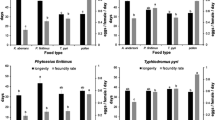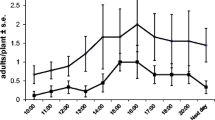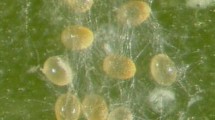Abstract
The number of eggs oviposited or left in the opisthosomas of dead mites (total eggs) was assessed for Metaseiulus occidentalis (Nesbitt), Neoseiulus fallacis (Garman), Typhlodromus pyri Scheuten or Amblyseius andersoni Chant when each was caged with either (1) no Tetranychus urticae Koch, (2) only odours of T. urticae, (3) ten eggs of M. occidentalis or (4) ten nymphs of M. occidentalis (T. pyri for M. occidentalis). The total eggs for the no prey versus odour tests did not differ within species; the levels were the greatest for N. fallacis > T. pyri > A. andersoni > M. occidentalis. Among treatments, egg means did not differ for M. occidentalis but they did for N. fallacis and T. pyri and similar trends were seen for A. andersoni. Egg means were usually less for mites held with ten predator nymphs than mites held with ten predator eggs or with no prey. Were adult females with nymphs absorbing rather than ovipositing their eggs or dying with them in their opisthosomas? Activity levels (walking) for adult females were no more for mites held with nymphs versus no food. The data indicated that interference by nymphs was not increasing the energy use of females and thus reducing egg levels. However, tests with ten nymphs, one egg and no adult female had egg losses from nymphal predation that could account for fewer eggs in cage tests. Overall, no evidence for absorption was found. If it occurs, it must be among younger eggs or mites exposed to less rapid prey losses than were the mites tested here; in addition, other stimuli may cause absorption. The total eggs in sticky-tape tests were greatest for N. fallacis > M. occidentalis > T. pyri > A. andersoni. Cage versus stick-tape data differed most for M. occidentalis because of cannibalism. All four mites cannibalized eggs but M. occidentalis did most rapidly and extensively. When starved, it laid all of its eggs before the other three species did. Such behaviours may enhance survival of M. occidentalis when prey become scarce.
Similar content being viewed by others
References
Croft, B.A. 1994. Biological control of apple mites by a phytoseiid mite complex and Zetzellia mali: long-term effects and impact of azinphosmethyl on colonization by Amblyseius andersoni (Acari: Phytoseiidae). Environ. Entomol. 23: 1317–1325.
Croft, B.A. and Croft, M.B. 1993. Larvae survival and feeding by immature Metaseiulus occidentalis, Neoseiulus fallacis, Amblyseius andersoni and Typhlodromus pyri (Acari: Phytoseiidae) on life stages of Tetranychus urticae Koch and phytoseiid larvae. Exp. Appl. Acarol. 17: 685–693.
Croft, B.A. and Zhang, Z.-Q. 1995. Assessing roles of individual species in a phytoseiid complex using adult female and immature traits: relevance to biological control. Proc. IX Int. Cong. Acarol. Columbus, OH. in press.
Croft, B.A., Brown, A.W.A. and Hoying, S.A. 1976. Organophosphorus resistance and its inheritance in the predaceous mite Amblyseius fallacis. J. Econ. Entomol. 69: 64–68.
Dunley, J.E. and Croft, B.A. 1990. Dispersal between and colonization of apple by the predaceous mites Metaseiulus occidentalis and Typhlodromus pyri (Acari: Phytoseiidae). Exp. Appl. Acrol. 10: 137–149.
Flanders, S.E. 1950. Oosorption and ovulation in relation to oviposition in the parasitic Hymenoptera. Ann. Entomol. Soc. Am. 35: 251–266.
Helle, W. and Sabelis, M.W. (eds) 1985. Spider Mites: Their Biology, Natural Enemies and Control, Vol 1B. Elsevier. Amsterdam.
Kuchlein, J.H. 1966. Mutual interference among the predaceous mite Typhlodromus longipilus Nesbitt (Acari: Phytoseiidae). I. Effects of predator density on oviposition rate and migration tendency. Meded. Rijksfac. Landbouwwet. Gent. 31: 740–746.
Mackauer, M. 1990. Host discrimination and larval competition in solitary endoparasitoids. Critical issues in biological control, M.Mackauer, L.Ehler and J.Roland (eds), pp. 41–62. Intecept Ltd, Hants, UK.
MacRae, I.V. 1994. Interspecific predation and cannibalism of immatures by adult female Metaseiulus occidentalis, Typhlodromus pyri (Acrai: Phytoseidae and Zetzellia mali): (Acari: Stigmaeidae). PhD Thesis. Oregon State University, 62 pp.
MacRae, I.V. and Croft, B.A. 1993. Influence of temperature on interspecific predation and cannabilism between Metaseiulus occidentalis (Nesbitt) and Typhlodromus pyri Scheuten (Acari: Phytoseiidae). Environ. Entomol. 22: 770–775.
Petersen, R.G. 1985. Design and Analysis of Experiments. Marcel Dekker Inc., NY.
Sabelis, M.W. 1985. Reproduction. In Spider Mites: their biology, natural enemies and control, Vol 1B, W.Helle and M.W.Sabelis (eds), pp. 73–82. Elsevier. Amsterdam.
Sanderson, J.P. and McMurtry, J.A. 1984. Life history studies of the predaceous mite Phytoseius hawaiiensis. Entomol. Exp. Appl. 35: 227–234.
Author information
Authors and Affiliations
Rights and permissions
About this article
Cite this article
Croft, B.A., Kim, S.S. & Kim, D.I. Absorption and cannibalism: do phytoseiids conserve egg resources when prey densities decline rapidly?. Exp Appl Acarol 19, 347–356 (1995). https://doi.org/10.1007/BF00052392
Issue Date:
DOI: https://doi.org/10.1007/BF00052392




